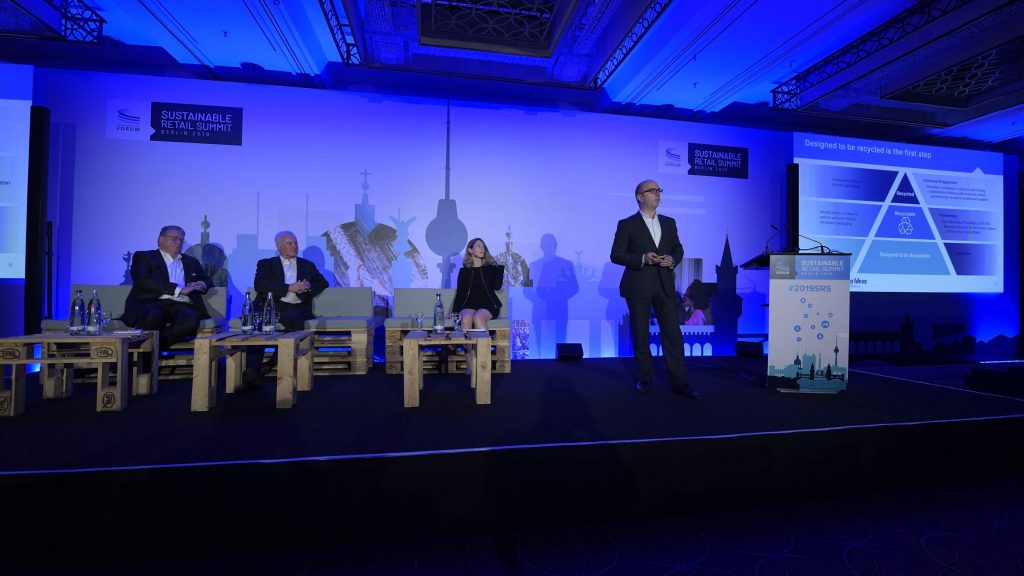At this year’s Sustainable Retail Summit, Amcor discussed the circular economy for packaging and the important role retailers play in making it possible.
In October 2019, Amcor was joined by CEFLEX and mtm plastics at the Sustainable Retail Summit in Berlin to determine what is needed, and from whom, to make a circular economy for packaging a reality. Key topics included the part retailers play in reaching and educating consumers about their role in recovery and recycling and the importance of extended producer responsibility (EPR) schemes.
The door remains wide open for collaboration, and the panellists invited retailers to work together with others in the value chain to develop more sustainable packaging and drive infrastructure standardisation and growth.
“CEFLEX has 140 member organizations with a total combined turnover of €1.2 trillion… we’ve got the whole value chain there, except we’ve got only one retailer… hopefully this time next year we’ll have 50.” – Graham Houlder, Co-Founder & Project Coordinator, CEFLEX
The Role of Retailers in Consumer Education
One of the hurdles facing a circular economy is making sure post-consumer packaging gets to collection points and back into the supply chain. This relies on consumers knowing what to do with their packaging after it is used. Research has found that the number of recycling symbols is confusing to consumers and this is where retailers and brands can help. Thanks to their direct interaction with consumers, the retailers and brands – with support from packaging suppliers – can guide people from intention to action with clarity, education and financial incentives.
For example, The PepsiCo Foundation partnered with The Recycling Partnership to launch All In On Recycling to make recycling as simple as possible for 25 million families across the US. This industry-wide challenge provides consumers with resources to recycle and properly dispose of packaging. And, PepsiCo is investing $10 million to support recycling education and operational programs that will increase collection of recyclables and reduce contamination. It is estimated that the program will help collect 1.9 million tons of quality recyclable materials over the next five years.
How to Level the Playing Field for the Industry: The Role of EPR Schemes
One possible way to accelerate infrastructure expansion and standardisation discussed at this years’ Sustainable Retail Summit was EPR schemes. This approach can provide a sustainable source of funding that supports recycling, while sharing the costs of recycling infrastructure and systems throughout the value chain.
If implemented well, EPR fees can help create incentives for more sustainable packaging design and boost innovation in the packaging supply chain. The fees can be invested back into recycling infrastructure, so that recycled materials can compete with virgin materials in the economy. With a strong market for recycled materials, the circular economy suddenly becomes economically viable.
“Leakage in Europe and the US is really small compared to other parts of the world. But it doesn’t make any sense collecting it [plastic packaging], if there isn’t an end market for it because it will sit on a landfill site and get blown or washed away… We need to take those materials and put them back into the economy by making them circular.” – Graham Houlder, CEFLEX
Should We Get Rid of Plastics Altogether?
One of the audience questions during the Sustainable Retail Summit was whether the “plastic is wrong” narrative needs to change.
A fact-based debate needs to take all environmental impacts of packaging choices into consideration. While plastic in the environment urgently needs to be addressed, what is often missing from the conversation is that other packaging options, such as glass and metal, can have environmental trade-offs and also contribute to waste and litter.
These other materials often have a larger carbon footprint because they are energy-intensive to produce, heavier and use more material per pack, and are less efficient to transport. Carbon footprint and climate change are more abstract and not as visible as litter and waste, however they should be taken into account in the discussion on how to improve packaging sustainability.
A big part of addressing plastics waste is bringing more standardisation to packaging design and recycling infrastructure. The recyclability of a package doesn’t change from one region to another. What does change, is what is collected and recycled in different countries around the world, based on regulations and the infrastructure available today.
“Europe has to be a role model for the world.” – Dr. Michael Scriba, Attorney at Law and Advisor to the Board of Directors of mtm plastics GmbH.
Europe has some of the most advanced recycling infrastructures in the world, which is a great source of information for other regions designing their future infrastructure. Still, across Europe, each country differs in which packaging types they collect and recycle. Consumer education and investment into recycling infrastructure and sustainable operating expenses for recycling and waste management, partly funded through the EPR schemes, can help overcome these challenges.
The Viability of Chemical Recycling
The final topic of discussion was whether chemical recycling might be the solution to a circular economy.
Some chemical recycling solutions can bring low-grade, mixed substances into the recycling loop, breaking them down to simpler building blocks to be used as feedstock to make new materials and chemicals of virgin-grade quality. Chemical recycling has exciting potential, however the technology is currently in pilot phase. If viable in the future, the processes will still require the same collecting and sorting processes as mechanical recycling.
While chemical recycling is a hope for the future, designing packaging for recyclability and increasing recycling rates is a challenge to be solved right now. Any work done by brands and retailers, along with their packaging suppliers, to design for recycling today will facilitate chemical recycling if it becomes commercially viable in the future.
“Let’s not use chemical recycling as an excuse for not doing what we need to do anyway… We’re going to work with what we have today and get ready for the future.” – Luca Zerbini, Vice President Film & Foil and Global Flexibles Sustainability Initiative, Amcor
This post was written and contributed by:
Luca Zerbini
Vice President Film & Foil and Global Flexibles Sustainability Initiative
Amcor


